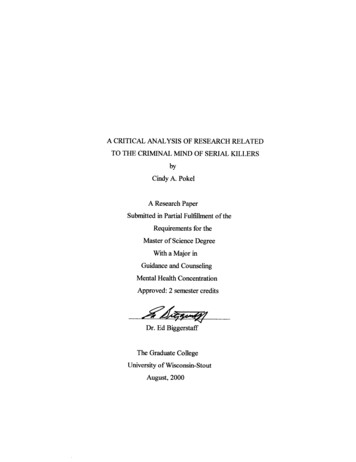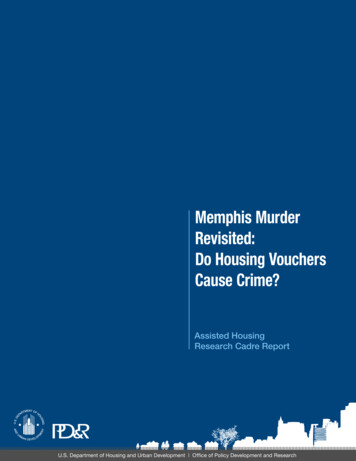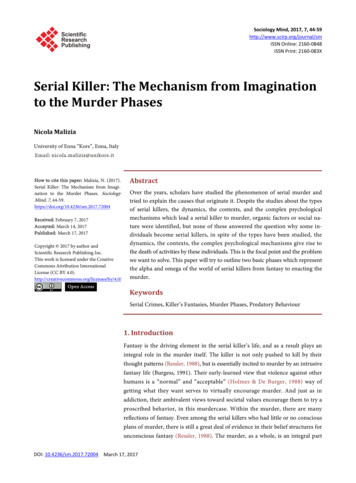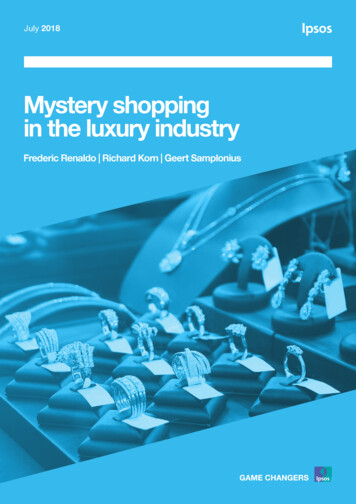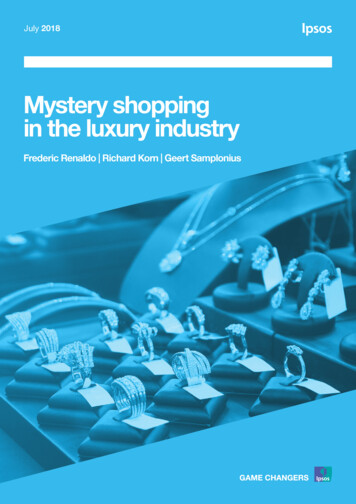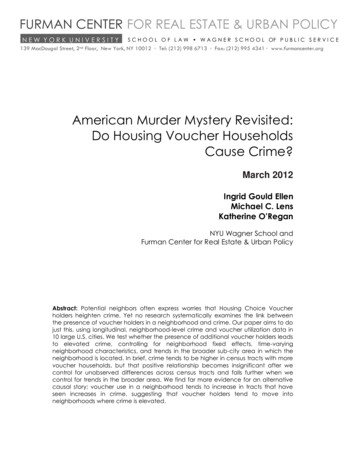
Transcription
FURMAN CENTER FOR REAL ESTATE & URBAN POLICYNEW YORK UNIVERSITY139 MacDougal Street,2ndS C H O O L O F L A W W A G N E R S C H O O L OF P U B L I C S E R V I C EFloor, New York, NY 10012 Tel: (212) 998 6713 Fax: (212) 995 4341 www.furmancenter.orgfurmancenter.nyu.eduAmerican Murder Mystery Revisited:Do Housing Voucher HouseholdsCause Crime?March 2012Ingrid Gould EllenMichael C. LensKatherine O’ReganNYU Wagner School andFurman Center for Real Estate & Urban PolicyAbstract: Potential neighbors often express worries that Housing Choice Voucherholders heighten crime. Yet no research systematically examines the link betweenthe presence of voucher holders in a neighborhood and crime. Our paper aims to dojust this, using longitudinal, neighborhood-level crime and voucher utilization data in10 large U.S. cities. We test whether the presence of additional voucher holders leadsto elevated crime, controlling for neighborhood fixed effects, time-varyingneighborhood characteristics, and trends in the broader sub-city area in which theneighborhood is located. In brief, crime tends to be higher in census tracts with morevoucher households, but that positive relationship becomes insignificant after wecontrol for unobserved differences across census tracts and falls further when wecontrol for trends in the broader area. We find far more evidence for an alternativecausal story; voucher use in a neighborhood tends to increase in tracts that haveseen increases in crime, suggesting that voucher holders tend to move intoneighborhoods where crime is elevated.
In the past few decades, the Housing Choice Voucher (HCV) program has expandedsignificantly.1 In 1980, about 600,000 low income households used federal rental housingvouchers to help support their rent; by 2008, that number had swelled to 2.2 million. While manyin the academic and policy communities embrace the growth in tenant-based assistance,community opposition to voucher use can be fierce (Galster et al., 2003; Mempin 2011). Localgroups often express concern that voucher recipients will both reduce property values andheighten crime. Hanna Rosin gave voice to the latter worries in her widely-read article,―American Murder Mystery,‖ published in the Atlantic Magazine in August 2008. A 2011opinion piece in the Wall Street Journal titled ―Raising Hell in Subsidized Housing‖ (Bovard,2011) echoed these concerns. Despite the continued publicity, however, there is virtually noresearch that systematically examines the link between the presence of voucher holders in aneighborhood and crime. Our paper aims to do just this, using longitudinal, neighborhood-levelcrime and voucher utilization data in 10 large U.S. cities. We use census tracts to representneighborhoods.The heart of the paper is a set of regression models of census tract-level crime that testwhether additional voucher holders lead to elevated crime, controlling for census tract fixedeffects—which capture unobserved, pre-existing differences between neighborhoods that houselarge numbers of voucher households and those that do not – and trends in crime in the city orbroad sub-city area in which the neighborhood is located. We also control for time-varyingcensus tract characteristics such as the extent of other subsidized housing, and in some models1The HCV program began as the Section 8 existing housing program or rental certificate program in 1974. As therental certificate program grew in popularity, Congress authorized the rental voucher program as a demonstration in1984 and later formally authorized it as a program 1987. The rental certificate program and the rental voucherprogram were formally combined in the Quality Housing and Work Responsibility Act of 1998. Throughconversions of rental certificate program tenancies, the HCV program completely replaced the rental certificateprogram in 2001. (Background information on the HCV program was condensed from U.S. Department of Housingand Urban Development, Office of Public and Indian Housing (1981), Housing Choice Voucher ProgramGuidebook. Washington, DC: U.S. Department of Housing and Urban Development, pgs 1-2 through 1-5.)2
we include measures of demographic composition. (We do not include time-varyingdemographic attributes in all models as the voucher holders themselves might be the source ofsome of these changes). Finally, we also test for the possibility that voucher holders tend to settlein higher crime areas.In brief, we find little evidence that an increase in the number of voucher holders in atract leads to more crime. While crime tends to be higher in census tracts with more voucherhouseholds, that positive relationship disappears after we control for unobserved characteristicsof the census tract and crime trends in the broader sub-city area. We do find evidence to supportan alternative story, however. That is, the number of voucher holders in a neighborhood tends toincrease in tracts that have seen increases in crime, suggesting that voucher holders tend to moveinto neighborhoods where crime is elevated.I.Background and Prior LiteratureThe Housing Choice Voucher (HCV) Program provides federally funded but locallyadministered housing subsidies that are mobile; they permit the recipient to select and changehousing units, as long as those units meet certain minimum health and safety criteria.2Households are generally eligible only if their income is below 50 percent of area medianincome (AMI). In addition, local housing authorities (HAs) are required to provide 75 percent ofvouchers to households whose incomes are at or below 30 percent of AMI.3 In addition to theseincome criteria, HAs may also impose additional priorities to accommodate local preferencesand housing conditions. Voucher recipients receive a subsidy, the value of which depends on the2Landlords also need to agree to participate and enter into contractual relationship with HUD for payment.See HUD‘s Housing Choice Voucher fact sheet, accessed July 20,2011.http://portal.hud.gov/hudportal/HUD?src /program offices/public indian housing/programs/hcv/about/fact sheet33
income of the household, the rent actually charged by landlords, and the rental payment standardfor housing established by the local HA.4 A voucher household whose rent is equal to or lessthan the local payment standard will pay no more than 30 percent of its income for gross rent.5Any rent above the payment standard is paid by the voucher holder. As with other affordablehousing programs, demand for vouchers greatly exceeds supply in most areas, with long waitingperiods for those who successfully qualify and get on HA waiting lists.6Local residents often oppose the entry of subsidized housing recipients (whether throughconstruction of subsidized rental housing or the in movement of housing voucher holders),voicing concerns that the presence of subsidized tenants will reduce property values and increasecrime. While the rationale behind these fears about crime is not always well-articulated,additional voucher holders could theoretically affect crime in a neighborhood, through fivedifferent pathways.First, if the voucher households are new to the neighborhood, they may add to the ranksof poor (or near poor) households. Economists and sociologists in particular have developed andtested robust theories on the link between poverty and crime, dating back to Becker‘s (1968)portrayal of the criminal as rational economic actor and Merton‘s (1938) sociological-based―strain theory.‖ Both theories predict that poor individuals (e.g., those who expect to derive moreincome from crime than from legal pursuits – accounting for the risk of incarceration and othercriminal penalties) will be more likely to commit crimes, and crime will be higher in higherpoverty neighborhoods.4HA payment standards are generally between 90 and 110% of HUD determined local Fair Market Rents (FMRs),but there are exceptions.5Gross rent includes utilities.6HAs close wait lists when the number greatly exceeds supply in the near future.4
Empirically, studies have found a connection between family income and the likelihoodthat members of that family will be involved in criminal activity (Bjerk, 2007; Hsieh and Pugh1993). Many studies have also found a relationship between the poverty rate in a neighborhoodand the crime rate (Hannon 2002; Krivo and Peterson 1996; Stults 2010). Hsieh and Pugh (1993)provide a useful meta-analysis, summarizing much of this work.7 In terms of what drives theassociation between concentrated disadvantage and violence, Sampson, Raudenbush, and Earls(1997) results suggest the mediator is collective efficacy – the social cohesion of neighborhoodresidents and the willingness of residents to intervene on behalf of others. Others have found thatcultural characteristics of neighborhoods, including respect for police authority, mediate therelationship between poverty and crime (Kirk and Papachristos, 2011).Given these relationships between poverty and crime, we might expect crime to rise in aneighborhood when the number of low-income voucher holders increases. Specifically, weexpect crime to rise (or rise more than it would otherwise) if the voucher holders who move intoa neighborhood have lower incomes than the households who would have otherwise moved in.8In many neighborhoods, at least in theory, voucher holders are likely to have lower incomes thanother potential residents because the rent subsidy makes affordable units that would otherwise beout of their reach. However, new voucher holders will not always have lower incomes thanexisting and potential residents – and in fact, the subsidy provided by the voucher means that lowincome voucher holders are arguably less disadvantaged than unsubsidized households with thesame income.9 Thus, while an increase in voucher holders could increase the level of7Concentrations of poverty beyond a certain tipping point may lead to even higher crime rates than expected giventhe level of poverty, due to a breakdown of social norms and reduced efficacy on the part of residents to organizeagainst criminal elements (Galster 2005).8In addition, if poverty only matters above a certain threshold, we might expect crime to increase if the number ofvoucher holders in a tract reaches a certain level of concentration.9The market value of the voucher is not included in Census measures of income.5
disadvantage in a neighborhood, it may not always do so in practice. Indeed, in lower incomeareas, an increase in voucher holders could potentially reduce economic disadvantage, given thepositive wealth effects of housing subsidies. Moreover, local housing authorities are permitted toscreen voucher applicants for criminal records and some do. Thus, if anything, voucher holdersthemselves are less likely to engage in criminal activity than other individuals with similarincomes who do not receive housing assistance (HUD 2001).A second potential mechanism through which voucher holders might affect crime is viaincreases in a neighborhood‘s income diversity or income inequality, if they move into higherincome neighborhoods. Several theories suggest that crime will grow with inequality, eitherbecause wealthier households and their property present targets to low-income households orbecause neighborhoods containing people of diverse backgrounds and limited shared experiencesare likely to be characterized by greater social disorganization, which can reduce social controland lead to increases in crime (Shaw and McKay 1942).10 Whatever the mechanism, manystudies of neighborhood crime find that greater income inequality is correlated with higher levelsof crime (Hipp 2007; Hsieh and Pugh 1993; Sampson and Wilson 1995). Hipp (2007), in a crosssectional analysis of census tract-level crime data in 19 cities, argues that the significantassociation between poverty and crime might actually be picking up a more robust relationshipbetween inequality and crime.Third, a growth in the voucher population might simply increase turnover in acommunity, which may also lead to elevated crime as social networks and norms break down.Sampson, Raudenbush, and Earls (1997) report a strong association between residentialinstability and violent crime in Chicago. Researchers have also found that neighborhood10In addition to being targets, higher income households may also make lower income households feel moreinadequate and drive them to theft. As noted, Merton‘s strain theory suggests that greater inequality will pressurehouseholds to feel a need to attain recognized symbols of status and wealth.6
attributes that are symptomatic of residential instability, such as white flight (Taub, Taylor, andDunham 1984) and house sale volatility (Hipp, Tita, and Greenbaum 2009) are associated withhigher crime. That said, the in-movement of voucher households can be a symptom as well as acause of residential instability, as larger out-migration from a neighborhood opens upopportunities for voucher holders. Moreover, voucher holders are primarily protected from rentincreases, and thus may be more residentially stable than other households. In this sense,additional voucher holders could lead to lower crime through enhanced community stability.Rosin (2008) proposes a fourth mechanism, suggesting that the problem lies morespecifically with housing voucher holders who have moved from demolished public housingdevelopments, who take with them the gang and other criminal networks that they developedthere. There is considerable evidence that crime rates are abnormally high in the distressedpublic housing developments that are typically targeted for demolition (Goering et al 2002;Hanratty, McLanahan, and Pettit 1998; Rubinowitz and Rosenbaum 2000). Thus it is possiblethat residents using vouchers to leave distressed public housing developments are more likely tocommit crimes—or have friends who are more apt to commit crimes—than the individualsalready living in the voucher holders‘ chosen destination neighborhoods. However, evidencefrom the Moving to Opportunity experiment suggests that youth who leave public housing mayreduce their criminal behaviors when they leave (Kling, Ludwig, and Katz 2005).Finally, while each of the above mechanisms presumes that the additional voucherholders are new arrivals to a neighborhood, a sizable number of voucher holders actually remainin their same unit when they first use their vouchers (Feins and Patterson 2005). Thus, someportion of the new vouchers in a neighborhood will generate no additional turnover, and bring7
additional economic resources to existing residents through the dollar value of their subsidy,which may dampen crime.In sum, a number of theories suggest that a growth in the number of housing voucherhouseholds in a neighborhood could affect crime, perhaps particularly property crime, if wethink that poverty leads to greater instances of crimes such as theft, burglary, and the like. Thesemechanisms, and much of the existing literature analyzing these mechanisms, suggest thatadditional voucher households in a neighborhood could plausibly increase crime. However, thereare also reasons to believe that additional voucher holders could have little effect on crime oreven reduce it.As for empirical work on subsidized housing and crime, there are very few studies thatdirectly test whether and how vouchers shape neighborhood crime. Several papers do explorehow other types of subsidized housing affect crime. Most estimate the simple associationbetween the presence of traditional public housing and neighborhood crime. As noted already,many studies find that crime rates are extremely high in and around distressed public housingdevelopments (Goering et al 2002; Hanratty, Pettit, and McLanahan 1998; Rubinowitz andRosenbaum 2000). But studies that examine how traditional public housing affects crime in thesurrounding area find more mixed results (Farley 1982; McNulty and Holloway 2000; Roncek,Bell, and Francik 1981).Perhaps more relevant to our analysis, a few studies actually evaluate how the creation ofscattered-site, public housing shapes crime levels. For example, Goetz, Lam, and Heitlinger(1996) examine whether and how creating scattered-site public housing (either through newconstruction or conversion of existing units) in Minneapolis affects crime in the surroundingneighborhoods. The authors find that police calls from the neighborhoods actually decrease after8
the creation of the new subsidized housing. However, they also find some evidence that as thedevelopments age, nearby crime increases over time. Galster et al. (2003) also study the impactof scattered-site public housing and find no evidence that the creation of either dispersed publichousing or supportive housing alters crime rates in Denver.Most recently, Freedman and Owens (2010) study whether the Low-Income Housing TaxCredit (LIHTC) activity within a county influences crime in that county. They exploit adiscontinuity in the funding mechanism for these tax credits to develop a model that allows themto better estimate a causal relationship between the number of LIHTC developments in a countyand crime. If anything, their findings suggest that LIHTC developments reduce crime. Given thatthey rely on county-level data, however, their results could be masking more localized effects.Although these studies provide some useful context, their relevance is limited, as theyfocus on programs that involve supply-side housing production. As such, these programs mayaffect neighborhoods not only through bringing in subsidized residents but also by changing thephysical landscape of the community. Perhaps more relevant to our work, in their assessment ofpublic housing demolition and patterns of homicide concentration, Suresh and Vito (2009) alsoconsider the concentration of Housing Choice Voucher holders. They find that homicides areclustered in neighborhoods that also house voucher recipients, however this work is purely crosssectional and descriptive.One unpublished paper specifically analyzes the effect of voucher locations onsurrounding crime rates. Van Zandt and Mhatre (2009) analyze crime data within a quarter mileradius of apartment complexes containing 10 or more voucher households during any monthbetween October 2003 and July 2006 in Dallas. Unfortunately, the police did not collect crimedata in these areas if the number of voucher households dipped below 10, leading to gaps in9
coverage and limiting the number and type of neighborhoods examined. Moreover, a consentdecree resulting from a desegregation case mandated that the Dallas Police Department collectthese crime counts surrounding voucher concentrations, which may have led the police to focuscrime control efforts on these areas. Still, the results are revealing. The authors find that clustersof voucher households are associated with higher rates of crime. However, they find norelationship between changes in crime and changes in the number of voucher households,suggesting that while voucher households tend to live in high-crime areas, they are notnecessarily the cause of higher crime rates.Van Zandt and Mhatre‘s results show that reverse causality may confound estimates ofhow voucher presence affects crime. As with many low-income households, voucher holdersface a constrained set of choices when deciding where to live. They can only live inneighborhoods with affordable rental housing,11and they may only know about—or feelcomfortable pursuing—a certain set of those neighborhoods, given their networks of social andfamily ties. In addition, they may be constrained by landlord resistance to accepting vouchers.Research on the Moving to Opportunity (MTO) demonstration program shows that landlordattitudes toward voucher holders play an important role in determining whether voucherhouseholds move to and stay in low poverty neighborhoods (Turner and Briggs 2008). Kennedyand Finkel (1994) find that most voucher holders rely on a narrow set of landlords, who serve the―Section 8 submarket.‖ This submarket tends to be concentrated in areas with higher vacancies,as landlords have fewer alternatives in these markets (see Galvez 2010). Collectively, theseconstraints may lead voucher households to choose neighborhoods that are declining and areexperiencing increases in crime. In related work, we find that voucher households occupy11As noted, households bear the full costs of rents that exceed the local rental payment cap.10
neighborhoods with higher than average crime rates, at least in cities (Lens, Ellen, and O‘Regan2011).12 Thus, in our analysis of impacts, we will attempt to control for voucher holders‘tendency to locate in high crime areas.II.Data and MethodsWe use a number of different data sources for our analyses, spanning numerous cities andyears. First, we collected neighborhood-level crime data for 10 U.S. cities from one of threesources: directly from police department web sites or data requests to the department (Austin,New York, and Seattle), from researchers who obtained these data from police departments(Chicago and Portland13), and from the National Neighborhood Indicators Partnership (NNIP) —a consortium of local partners coordinated by the Urban Institute to produce, collect, anddisseminate neighborhood-level data (Cleveland, Denver, Indianapolis, Philadelphia, andWashington, DC).14 For all cities except Philadelphia, we include all property and violent crimescategorized as Part I crimes under the Federal Bureau of Investigation‘s Uniform CrimeReporting System.15 In all cities except for Denver, neighborhoods are proxied by census tracts.(Denver crime data are aggregated to locally defined neighborhoods, which are typically two tothree census tracts.)12We find that voucher holders live in lower crime neighborhoods than their counterparts in place-based, subsidizedhousing, however.13We are grateful to Garth Taylor for providing Chicago crime data and to Arthur O‘Sullivan for providing crimedata for Portland.14We thank the following NNIP partners: Case Western Reserve University (Cleveland), The Piton Foundation(Denver), The Polis Center (Washington, DC), and The Reinvestment Fund (Philadelphia).15Part I violent crimes include homicide, rape, aggravated assault,and robbery, while Part I property crimes includeburglary, larceny, motor vehicle theft, and arson. Philadelphia did not provide data on sexual assaults or homicides,and New York City did not provide data on sexual assaults. Thus, those crimes are not included in overall totals forthose cities.11
Our second key source of data comes from the U.S. Department of Housing and UrbanDevelopment (HUD): household-level data on voucher holders and public housing tenantsnationwide from 1996 to 2008, which we aggregate to the census tract-level, in order to link toour crime data. Voucher data are provided to HUD by local housing agencies, and should reflectthe count of assisted households in a census tract as of the end of the specified year.Working with administrative data brings challenges. The data on subsidized householdsare household-level files that come to HUD from local housing agencies, and as such, are subjectto potential data quality inconsistencies across these different data collecting entities.Unfortunately, we are missing housing voucher data almost entirely for some cities in someyears, most notably, Philadelphia and Seattle. Given the resulting short panels in these two cities(together with the short panel in New York City due to a small number of years of crime data),we re-estimate all the models in this paper on a smaller sample of seven cities for which we havemore complete data. As the results are nearly identical, we present results from estimations onthe full set of ten cities.16Additionally, we also find some anomalies in particular census tracts for certain years.Some of these gaps are explained by HUD‘s inability to geocode all of the addresses for voucherholders collected by the housing authorities, particularly in the early years. HUD researchersestimate that the census tract ID is missing and irretrievable for about 15 to 20 percent of thecases in 1996 and 1997, but this rate gradually declines over the time period to about six percentby 2008. In our sample, we find that the reported count of voucher holders in about 2 percent oftract-years deviates sharply from the voucher counts in that tract‘s previous and subsequent16We have incomplete data on vouchers for Philadelphia and Seattle data from 2002 through 2006, in 1996 forChicago, Cleveland and Indianapolis, and in 2002 for Portland. We drop these city-years from the dataset.12
years.17 We assume that these counts are incorrect and smooth the data using a linearinterpolation to derive what we hope to be more precise estimates of voucher counts for thosetracts in those years.18 While these data inconsistencies and coverage gaps will add measurementerror, we have no reason to believe that they are systematically related to neighborhood crime.As a robustness test, we also estimate models that simply omit these data points, and the keyresults are unchanged.As shown in Appendix A, our crime and voucher data for these cities cover portions ofthe 1996 to 2008 period. We have data for at least 11 years in five of our cities (Austin, Chicago,Cleveland, Denver and Indianapolis)19 and for the remaining five cities, we have data forbetween four and eight years.In addition to crime and voucher data, we have access to a limited number of controlvariables that are available at the census tract level, which help us to provide a more preciseestimate of the relationship between voucher locations and crime. First, we control for annualpopulation counts, using linear interpolation to estimate population between the 1990 and 2000decennial census years and the American Community Survey 2005-2009 average estimates.Second, we control for additional tract characteristics that may vary over time to capture changesin both the housing stock and total population. Specifically, we include the number of publichousing units in a tract in a given year, using annual data provided by HUD and the estimated17Specifically, we consider a tract‘s voucher data to be invalid if the number of vouchers in year t was either at least25 more than the number of vouchers in year t-1 (and at least 25 less in year t 1) or at least 25 less than the numberof vouchers in year t-1 (and at least 25 more in year t 1). We use a threshold of 25 because the mean number ofvouchers in the sample‘s tracts is 25. In other words, we assume that changes as large as an entire census tract‘stypical count, followed by an immediate equally large ‗correction‘ must be attributable to uneven data collectionrather than actual changes in program utilization. Using this method, we identified voucher counts in 771 tract-yearsas invalid (2.4% of the total).18Following Powers (2005), we use the PROC EXPAND tool in SAS to modify the invalid data using a linearinterpolation.19In the case of Cleveland, we use 1997 and 1999 crime data to estimate the missing 1998 crime rates with a linearinterpolation.13
annual vacancy rate, and homeownership rate. In some models, we also include time-varyingcontrols for neighborhood demographic characteristics, such as poverty rate and racialcomposition, using decennial census data and the American Community Survey (ACS). Becausethese demographic data are only available for 1990, 2000, and an average for 2005-2009, welinearly interpolate the decennial and ACS data, using the bookend years, as we do withpopulation estimates.20Descriptive StatisticsTo provide some context for our sample, Table 1 displays population-weighted means inthe year 2000 for the full sample of census tracts, along with the sample of all tracts in U.S. citieswith population greater than 100,000. Our sample of cities in year 2000 had, on average, fewervouchers and more public housing per tract than those in all large U.S. cities. Also, tracts in oursample have a greater share of poor, non-Hispanic black and renter households and a smallerproportion of non-Hispanic whites.In terms of crime, Table 2 compares the average total, violent, and property crime ratesper 1,000 persons for our sample and for the 222 U.S. cities with population greater than 100,000for which crime data were available from the FBI Uniform Crime Report system in 2000. Theaverage crime rate in our sample in 2000 was about 68.8 crimes per 1,000 persons, withsubstantial variation across cities.21 As a comparison, the 2000 crime rate for the sample of U.S.cities with populations greater than 100,000 with crime data available was 60.9 per 1,000persons, so consistent with the slightly higher poverty rates, the neighborhoods in our sample ofcities have slightly higher crime rates on average. Property crimes (burglary, larceny, theft, andmotor vehicle theft) are the most common types of crime, with violent crimes (murder, rape,20For the purposes of interpolation, we assume that the five-year ACS average represents the middle year, or 2007.21This average excludes New York City as we do not have crime data for New York City in 2000.14
robbery, and aggravated assault) occurring much less frequently. In both our sample andnationwide, crime rates declined between 2000 and 2007. Table 3 displays the distribution ofvoucher households and all households in each city by household income relative to the federalpoverty line. Given the income requirements of the voucher program, it is not surprising thatvoucher households have lower incomes than the general population, but there are two additionalobservations worth noting. First, the overwhelming majority of voucher holders have incomes ator below the poverty line. Second, while the local income standard will vary due to its relianceon area median income (or AMI), there is a somewhat surprising uniformity across cities in thepoverty status of vouch
control for unobserved differences across census tracts and falls further when we control for trends in the broader area. We find far more evidence for an alternative causal story; voucher use in a neighborhood tends to increase in tracts that have seen increases in crime, suggesting that voucher holders tend to move into
